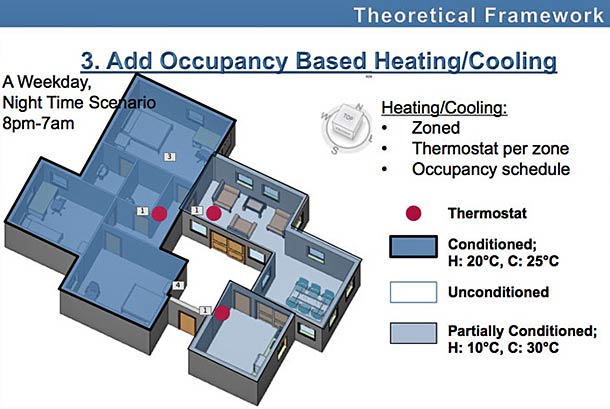Ph.D. student eying effectiveness of occupancy-based HVAC system

Simge Andolsun
Significant energy savings could be realized in small, approximately 1,000 square foot homes in hot climates with an air conditioning system being researched by Simge Andolsun, a Ph.D. architecture student at Texas A&M, that cools rooms based on where people are at different times during the day.
“Residential energy cost is a significant burden, particularly for low-income households,” she said. “A total of 38.6 million households are in need of low-income home energy assistance in the U.S., and Texas ranks second in the nation in the number of housing units eligible for low-income home energy assistance.”
Andolsun is researching the system with a $15,000 dissertation fellowship from Texas A&M’s Office of Graduate Studies, a $10,000 graduate student-in-aid grant from the American Society of Heating, Refrigerating and Air-Conditioning Engineers and support from Texas A&M’s [Energy Systems Lab] (http://esl.tamu.edu) , where she is a research assistant.
She is studying applications of two concepts, developed by her faculty advisor, Charles Culp, professor of architecture and ESL associate director, that could provide a 30- to 50-percent reduction in energy costs in hot and humid climates in the U.S.: “partial conditioning of space,” in which only rooms in use are cooled with conditioned air, which is also used to partially condition unoccupied rooms, and “partial use of space” — for example, an unconditioned atrium is comfortable for use much of the year because it uses conditioned air from other spaces.
The “partial conditioning” heating, ventilation and air conditioning system that Andolsun is researching pulls in outside air, conditions it and routes it, during overnight hours for instance, first to bedrooms, then from the bedroom to the currently unoccupied living room.
Andolsun visited a Habitat for Humanity house in Bryan to gather data to design a baseline virtual residence for the study and is using a second virtual residence, based on the Bryan residence design, modified with a “partial conditioning” HVAC system and an atrium to test the “partial use of space” concept.
Comparing the energy use of the two houses with energy modeling tools, she will reference her findings to create design guidelines for residential HVAC design in hot and humid climates.
“How much energy will be needed to move the air to unoccupied zones? How much air should be sent? Do we use a controlled airflow? Do we move the cool air with a fan, or will the air move with its own flow? How much money would such a system save? These are some of the questions the study will address,” said Andolsun.
“Implementing these concepts could improve people’s health because more fresh air gets to where they actually are in the house, depending on the time of day, instead of what is done today, which is recirculate inside air and let fresh air leak in from outside,” said Culp.
Tags
- architecture
- energy
- energy sustainability
- energy systems
- environment
- graduate work
- research
- rss
- scholarships
- sustainability
- technology
Related Posts
Culp leads software design effort at ESL

Light pipe tests under way at daylighting lab
Students craft useful building software plugins for Revit
Texans realize energy savings from ESL recommended codes
Haberl named fellow of international energy organization
Follow Us
Facebook Twitter Vimeo Youtube Flickr RSS
Recent Posts

Planning prof heads study of disaster housing aid

A message from the dean

Former student remembered as expert planner

Leading educator named new head of Architecture Dept.





_thumbnail_small.png)
